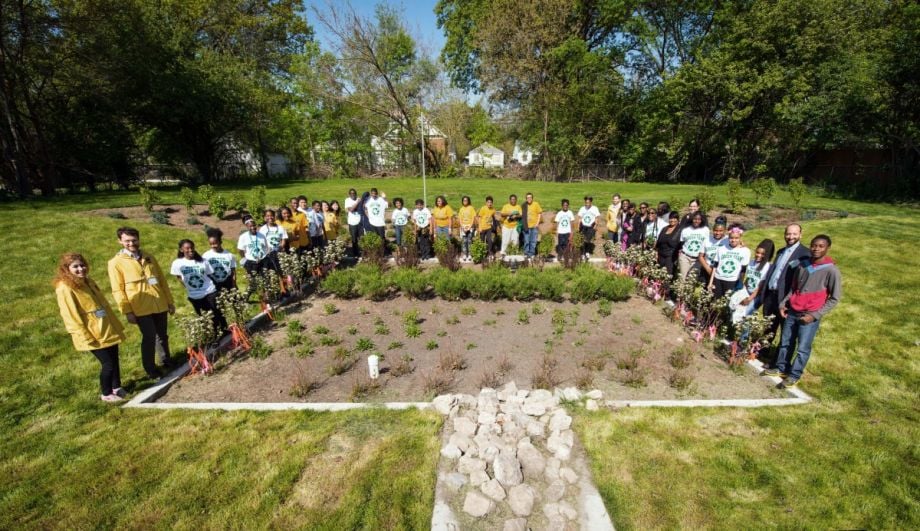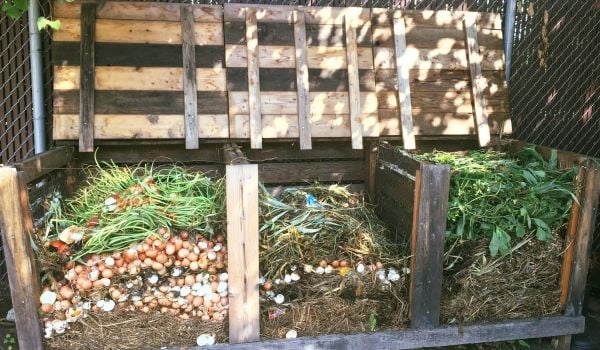Four vacant lots on Detroit’s west side have been given new life as stormwater retention gardens, each capable of corralling up to 300,000 gallons of water below ground per year, while creating a beautiful, common space for neighbors up above. Initiated by an interdisciplinary team of master’s students lead by University of Michigan professor Joan Nassauer, the project represents a few significant firsts: the first green stormwater infrastructure project to receive investment from the Detroit Water and Sewerage Department (DWSD); the first time that department and the Detroit Land Bank Authority have collaborated. And with their massive capacity and appealing design, the stakeholders are also hoping to prove just how much green infrastructure can do.
“Their performance in terms of stormwater management is kind of extraordinary as compared with other green stormwater infrastructure projects at this scale,” says Nassauer. Typical interventions are designed to handle the 90th percentile storm event, about an inch of rainfall. These sites can retain closer to 2.3 inches of rainfall. Virtually all of a one- or two-year flood will be retained on site, and nearly half of a hundred-year storm. “We aren’t just making sure that the stormwater that falls on these properties stays there, we’re grabbing water from half the block and putting it in these little pilot garden sites.”
The completion of the first four sites, all located in the Cody Rouge neighborhood, was officially celebrated this May, but the idea was sparked nearly a decade ago. Nassauer and the students in her landscape ecology perception and design lab were looking at vacant properties to design green infrastructure plans for entire neighborhoods. Based on her experience, Nassauer always gives her students one guiding principle: Whenever possible, use the land to manage the water. Green roofs, green walls, permeable pavers all have their place in stormwater management, she says, but where space permits, using the land itself often costs less. She and her students developed eight water retention and infiltration concepts for vacant lots. By far the most spatially efficient was using the below-grade space once occupied by a basement.
Detroit has no lack of vacant basements attached to vacant houses, thousands of which are owned by the Detroit Land Bank Authority, which tries to auction them off and demolishes when it can’t. “That’s important because Detroit, compared with other legacy cities, has less permeable soil,” largely composed of clay, says Nassauer. So where a large hole already existed in the ground, “we thought it only made sense to fill that hole with a far more permeable material.”
She’s careful to point out that the gardens don’t actually match the basement footprints exactly, an approach being tested in Milwaukee. With its current funding sources, the Land Bank Authority isn’t allowed to use demolition money to build green infrastructure, and must fill the resulting hole post demolition. Nassauer and Palencia Mobley, deputy director and chief engineer of DWSD, had hoped to come right in after demolition and install the stormwater retention tools in the hole left behind. Instead DWSD constructed the holes after the fact, working with the engineering firm Tetra Tech. Two adjacent lots were determined to provide the most benefit, so the gardens are constructed in the middle between the two. They’re filled with a highly porous engineered soil, and use the basements’ old sewer drain to send water back into the sewer system if needed after storms.
Detroit, like many cities, has a combined sewer system, fed by both wastewater and stormwater. Mobley says the city had already spent several billion dollars to control sewer overflows, per EPA mandate, eventually treating 95 percent of the excess water that couldn’t reach wastewater treatment plants during storm events. The city went from discharging roughly 30 billion gallons of combined sewage into the river per year, down to around 3 billion gallons per year. But to remedy the rest would have cost another billion dollars at least, so the department negotiated with the EPA to try green stormwater infrastructure instead.
The four vacant lot pilot sites are the first investment under that new agreement. Because of their large capacity, and because the gardens are equipped with devices to monitor the quantity and quality of water retained, these sites were fairly costly: $125,000 each. Mobley says the department is already looking to create more similar sites, and to continue working with the land bank, though because of the cost, future projects might look slightly different. Maybe DWSD would use three or four adjacent lots, for example.
“We’re looking at additional vacant lots to do bioretention on, because one of the things it does, and you can’t negate this at all, is the social aspect that it provides for the residents in terms of how they feel about themselves, how they feel about the neighborhood,” says Mobley.
In a city with thousands of vacant properties, the aesthetic and social benefits to the neighborhood were of primary concern to Nassauer and other project partners. Early in the process, they conducted a survey of 163 households living within 800 feet of the pilot sites to determine how they’d affect neighbors. Residents were asked to compare their own and their neighborhood’s well-being in relation to control vacant lots maintained in the usual way by the land bank — mowed about once a summer — with visualizations of the completed gardens, which are planted with low, flowering plants. They were also asked to compare the control with a still-vacant lot that was better maintained, mowed weekly.
When asked how each of the types of lots would affect the economic value of their homes, how safe they would feel in their neighborhood, how often they would walk around, how often they would interact with neighbors, the pilot design visualizations all performed significantly better.
“The engineering is very efficient, but to people in the neighborhood, it’s a beautiful garden that’s going to be maintained,” says Nassauer. “Stormwater management, a lot of it, not all of it but a lot of it, is about downstream benefits. That is cleaning water, holding water, so you don’t pollute downstream. But if you can design green infrastructure so that people who live next door see that it really benefits them and their quality of life, that’s the approach we took.”
DWSD will check the drainage inlets and outlets on an annual basis, and work with a combination of city departments to maintain the garden. Tetra Tech and Nassauer’s research collaborators will monitor the data on water quality and quantity. Nassauer says the collaboration among different entities that this research project sparked will be one of its most lasting benefits. Faculty involved in public health, urban planning, law and other disciplines worked with community groups like the Cody Rouge Community Action Alliance. “The idea is that we, in doing this work, create connections. We answer problems, offer solutions, but we create connections among people who will benefit from working together.”
The Works is made possible with the support of the Surdna Foundation.
Jen Kinney is a freelance writer and documentary photographer. Her work has also appeared in Philadelphia Magazine, High Country News online, and the Anchorage Press. She is currently a student of radio production at the Salt Institute of Documentary Studies. See her work at jakinney.com.
Follow Jen .(JavaScript must be enabled to view this email address)





_600_350_80_s_c1.JPEG)











